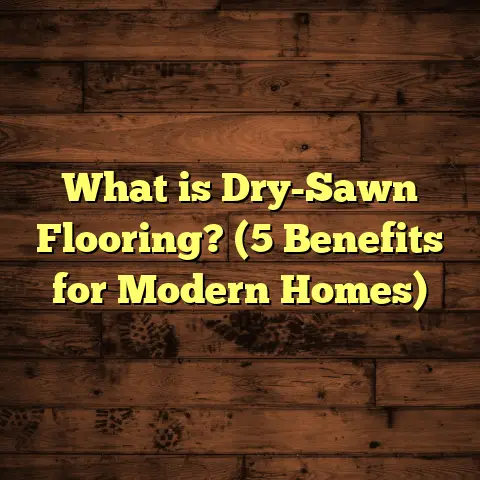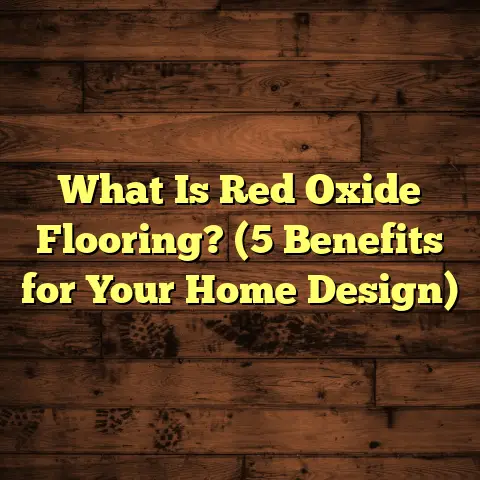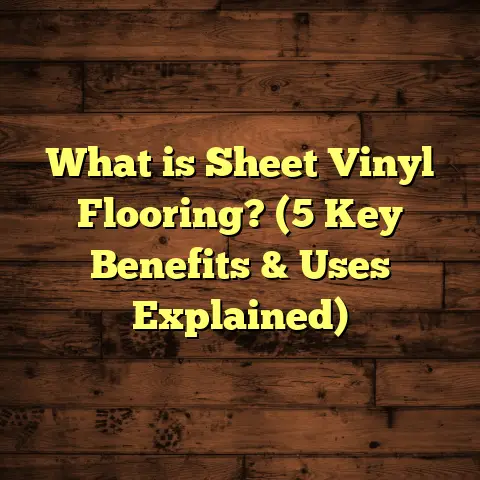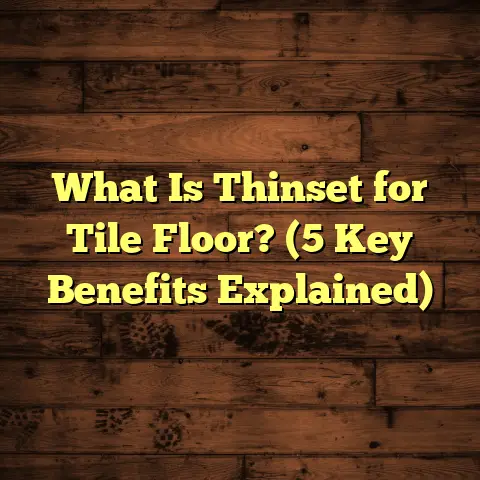What is a Hardwood Floor? (5 Benefits for Your Home)
Have you ever stopped to think about what truly makes a house feel like a home? For me, that feeling often starts from the ground up—literally. When I first walked into a home with hardwood floors, I was amazed at how something as simple as wood beneath my feet could change the entire vibe of a room. It’s not just about aesthetics; hardwood floors bring so much more to the table. If you’re curious about what hardwood floors really are and why they might be the perfect fit for your home, hang tight—I’m going to share everything I know, from personal experiences to some pretty convincing data.
What Is a Hardwood Floor?
Hardwood flooring is exactly what it sounds like: floors made from solid wood planks. But there’s a lot packed into that simple definition. Hardwood comes from trees that lose their leaves annually (deciduous trees), like oak, maple, cherry, and walnut. These woods are dense and sturdy, which makes them ideal for flooring that needs to withstand years of foot traffic.
When I got into flooring work years ago, I quickly learned that not all wood floors are created equal. There’s solid hardwood, which is a single piece of wood—usually about 3/4 inch thick—and then there’s engineered hardwood, which is a real wood veneer layered over plywood or composite material. Engineered hardwood is especially useful in places with fluctuating humidity because it’s less likely to warp or swell compared to solid hardwood.
Personally, I prefer solid hardwood for rooms with stable environments and engineered hardwood for basements or bathrooms where moisture can be an issue.
How Hardwood Floors Are Made
To understand hardwood better, let me tell you how it’s made. The process starts with selecting the right logs. They’re cut into planks, then kiln-dried to remove moisture. This drying process is crucial because it helps prevent warping later on.
After drying, the planks are milled to size and sanded smooth. Some are stained or finished right away, while others are sold unfinished so homeowners or contractors can customize the look after installation.
The finishing touches involve applying sealants like polyurethane or oil-based finishes that protect the wood from scratches and stains. I’ve applied finishes countless times and can tell you firsthand: the right finish can make a huge difference in both appearance and longevity.
1. Timeless Beauty That Never Goes Out of Style
Let’s kick things off with one of the most obvious reasons people choose hardwood: it looks incredible.
I can’t count how many times I’ve walked into homes with hardwood floors and immediately felt a sense of warmth and character. Unlike synthetic materials that try to mimic wood, nothing beats the natural grain pattern, knots, and color variations you get with real wood.
Why Does Hardwood Look So Good?
It’s all about those natural details. No two planks are exactly alike—each has its own story told through its grain and color. When light hits hardwood floors, it reflects differently depending on the angle and finish, giving your floor a dynamic look that changes throughout the day.
There’s also something about wood’s warmth—both visually and physically—that makes spaces feel cozy yet elegant. In my own home, hardwood floors have become a focal point. Guests often comment on how inviting my living room feels, and honestly, I think it’s largely thanks to those wooden planks underfoot.
What Styles Work Best?
Hardwood floors aren’t just for traditional or rustic homes. They come in various finishes and species that can suit any style:
- Light-colored woods like maple or ash brighten up modern spaces.
- Rich darker woods like walnut or mahogany add luxury to formal rooms.
- Distressed or hand-scraped finishes bring character to farmhouse or vintage designs.
I once helped a family choose flooring for their newly built contemporary home. They picked wide-plank oak with a matte finish. The result? Sleek yet warm interiors that felt balanced and timeless.
Data You Can Trust
According to a 2023 survey by the National Wood Flooring Association (NWFA), over 80% of homeowners say they prefer homes with wood floors because they feel more welcoming and stylish. Real estate experts back this up too—homes with hardwood floors tend to attract more buyers faster.
2. Durability That Lasts Generations
You might wonder: “Are hardwood floors really worth it if I have kids or pets?” The answer is yes—but there are some things to keep in mind.
What Makes Hardwood Durable?
The secret lies in the density of the wood species. Some woods are naturally harder than others and can withstand more wear and tear.
The Janka Hardness Scale measures how hard different woods are by testing the force needed to embed a steel ball halfway into the wood. Here are some examples:
- Hickory: 1,820 (very hard)
- Red Oak: 1,290 (hard)
- Maple: 1,450 (hard)
- Pine: 420 (soft)
I usually recommend oak or hickory for families who want durable floors that still look beautiful.
My Personal Experience
When my kids were toddlers, our floor took a beating—spills, dropped toys, even an accidental scratch from a dog’s nails now and then. But after sanding and refinishing every few years, the floor looked nearly new again. Hardwood isn’t indestructible but it’s definitely repairable.
How Long Do Hardwood Floors Last?
With proper care, hardwood can last for decades—even centuries! Some historic homes still have their original hardwood floors intact after more than 100 years.
A study by the Hardwood Federation found that over 90% of homes with hardwood flooring reported no major issues after 25 years of use when maintained properly.
3. Improved Indoor Air Quality
This might surprise you: your choice of flooring impacts your home’s air quality more than you think.
Why Hardwood Helps
Hardwood floors don’t trap dust mites, pollen, pet dander, or mold spores like carpet does. These allergens can aggravate asthma or allergies in sensitive individuals.
I switched from carpet to hardwood in my bedrooms after noticing my son’s seasonal allergies were worsening. Almost immediately, his symptoms improved—a relief for our whole family.
Scientific Backing
The Environmental Protection Agency (EPA) highlights that hard flooring surfaces significantly reduce indoor allergens compared to carpeting.
A study published by the American Journal of Respiratory Medicine showed that homes with hard flooring had 30% fewer airborne allergens than carpeted homes.
Cleaning Made Easy
You don’t need fancy cleaning products either—just regular sweeping or vacuuming keeps your floors free from dust buildup. Mopping occasionally with a gentle cleaner keeps them shiny without harming the finish.
4. Increased Home Value
If you’re thinking about selling your home someday, this one might catch your attention.
How Hardwood Floors Affect Resale Value
Real estate agents often say hardwood floors are one of the top features buyers look for when house hunting. That’s because they signify quality and care.
In fact, a report by Zillow in 2022 showed homes with hardwood floors sell for an average 2-5% higher price than comparable homes without them.
Faster Sales Too
Not only do hardwood floors mean higher prices—they also often lead to quicker sales. Buyers feel confident that they won’t have to replace flooring anytime soon.
I’ve seen this firsthand as a contractor when staging homes for sale. Homes with freshly refinished hardwood usually attract more offers within days of listing.
What If Your Home Doesn’t Have Hardwood Yet?
If your home currently has carpet or laminate, consider upgrading before selling—or even just refinishing existing wood underlayments if you have them. The investment often pays off handsomely in return.
5. Easy to Maintain and Clean
One of the things I appreciate most about hardwood is how little fuss it requires day-to-day.
Simple Cleaning Routine
Hardwood floors don’t hold onto dirt and stains like carpet does. Sweeping or vacuuming a few times a week usually does the trick.
For mopping, I use a damp mop—not soaking wet—to avoid water damage. Occasionally I apply wood-safe cleaners to maintain the finish’s glow.
Avoiding Common Pitfalls
Some mistakes I see people make:
- Using harsh chemicals or ammonia-based cleaners that damage finishes
- Over-wetting during mopping leading to swelling or warping
- Scratching floors by dragging furniture without protective pads
I always advise clients to use felt pads under furniture legs and clean spills immediately.
Longevity Through Maintenance
Regular maintenance like refinishing every 7-10 years can keep your hardwood floors looking fresh for decades. Refinishing involves sanding off surface scratches and applying a new finish layer—a process I’ve done hundreds of times professionally.
More Reasons Hardwood Floors Win
Since we’re chatting like friends here, I want to share some extra benefits I didn’t mention earlier:
Environmental Friendliness
Hardwood is renewable when sourced responsibly from well-managed forests. Many manufacturers offer FSC-certified wood products ensuring sustainable harvesting practices.
Plus, because hardwood lasts so long, it reduces waste compared to replacing cheaper flooring every few years.
Versatility in Design
You can sand and refinish hardwood multiple times—changing stain colors or finishes—without replacing the floor entirely. This flexibility lets you refresh your home’s look over time without major renovation costs.
Addressing Common Questions About Hardwood Flooring
Since I get asked these all the time, let me clear up some frequent concerns:
Does Hardwood Scratch Easily?
Yes and no. Hardwood can scratch but harder species resist scratches better than softwoods. Plus, minor scratches can be buffed out during refinishing.
Is Hardwood Suitable for Kitchens?
Absolutely! It adds warmth and elegance to kitchens—but spills should be cleaned quickly to avoid damage from moisture.
How Does Engineered Hardwood Compare?
Engineered hardwood offers similar looks but better moisture resistance—ideal for basements or bathrooms where solid wood isn’t recommended.
A Case Study From My Own Projects
Let me share one project where hardwood truly transformed a home:
I worked with a couple renovating their century-old house. The original pine floors were damaged but salvageable. After careful sanding and staining with a warm honey color, we sealed them with a durable matte finish.
The couple told me their home suddenly felt inviting—like it had history but was freshened up for modern living. They also noticed fewer dust allergies once carpets were removed in bedrooms.
Installation Insights From My Experience
Installing hardwood flooring isn’t just about laying down planks—it requires preparation and skill:
- Subfloor must be clean, dry, level
- Acclimate wood planks in room for several days before installation
- Use appropriate fasteners or glue depending on subfloor type
- Leave expansion gaps around edges for natural wood movement
I always tell clients: good installation makes all the difference between floors that last decades versus those that warp or squeak quickly.
Cost Considerations
Hardwood floors vary widely in price depending on species, finish, and installation method:
| Species | Material Cost (per sq.ft.) | Installation Cost (per sq.ft.) | Total Cost Range (per sq.ft.) |
|---|---|---|---|
| Oak | $3 – $6 | $3 – $7 | $6 – $13 |
| Maple | $4 – $7 | $3 – $7 | $7 – $14 |
| Walnut | $5 – $10 | $4 – $8 | $9 – $18 |
| Hickory | $4 – $8 | $3 – $7 | $7 – $15 |
| Engineered | $3 – $9 | $3 – $7 | $6 – $16 |
While upfront costs can seem high compared to laminate or vinyl, remember you’re investing in longevity and value.
Final Thoughts From Me
If you’re still on the fence about hardwood floors after all this info—I get it! Choosing flooring is a big decision. But I hope sharing my stories alongside facts gave you a clearer picture of why hardwood continues to be loved by homeowners around the world.
It’s about more than just floors; it’s about creating a space where life happens—comfortable, healthy, beautiful spaces that last generations. If you want help figuring out what type of hardwood fits your needs or how best to care for it long-term, ask away—I’m here for you!
Would you like me to add sections on specific maintenance routines or recommendations on tools for DIY installation? Or maybe a guide on selecting wood species based on climate? Just let me know!





